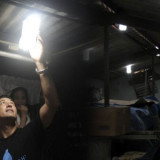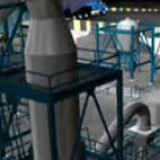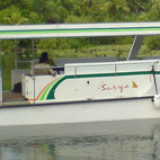Plastic Waste in Rural Roads Construction
Plastic in different forms is found to be almost 5% in municipal solid waste, which is toxic in nature. It is a common sight in both urban and rural areas to find empty plastic bags and other type of plastic packing material littering the roads as well as drains. Due to its biodegradability it creates stagnation of water and associated hygiene problems. In order to contain this problem experiments have been carried out whether this waste plastic can be reused productively in the construction of roads. The experimentation at several institutes indicated that the waste plastic, when added to hot aggregate will form a fine coat of plastic over the aggregate and such aggregate, when mixed with the binder is found to give higher strength, higher resistance to water and better performance over a period of time. Therefore, it is proposed that we may use waste plastic in the construction of Rural Roads.
Past Experience
Though approved specifications were not available in the beginning, with the help of research carried by Prof. Vasudevan of TCE, Madurai, Prof. Justo and Prof. Veeraragavan at Bangalore University and research carried out by Scientist at CRRI, New Delhi, several trial roads were constructed using waste plastic. Though detailed performance studies were not systematically planned and done on all such roads, generally it has been found that the roads constructed using waste plastic, popularly known as Plastic Roads, are found to perform better compared to those constructed with conventional bitumen. Further it has been found that such roads were not subjected to stripping when come in contact with water. With the experience gained over the years of construction of roads using waste plastic, CRRI as well as TCE has firmed up the specifications for the use of waste plastic and shared the specifications with organizations willing to construct the roads with waste plastic.
The present guidelines are based on the presentations made by Dr. Sangita, Sr. Scientist, Flexible Pavement Division, CRRI and the literature supplied by Dr. R. Vasudevan of Thiagarajar College of Engineering, (TCE), Madurai.
Specifications for Waste Plastic
The following types of waste plastic can be used in the construction of rural roads:
- Films (Carry Bags, Cups) thickness up to 60micron (PE, PP and PS)
- Hard foams (PS) any thickness
- Soft Foams (PE and PP) any thickness.
- Laminated Plastics thickness up to 60 micron (Aluminum coated also) packing materials used for biscuits, chocolates, etc.,
Please note that Poly Vinyl Chloride (PVC) sheets or Flux sheets should not be used in any case.
Further, the waste plastic modifier should be free from dust and is to be shredded, preferably to 2-3 mm particle size. While CRRI specified that the shredded waste plastic should pass through 3 mm sieve, Dr. Vasudevan is of the opinion that it has to pass through 4.75 mm sieve and retained on 1 mm. This also indicates indirectly that the size of the shredded bitumen should normally be 2-3 mm for better spread and coating the aggregate.
Method of Road Laying
Dry process is recommended for isolated works. It is recommended that the percentage of shredded waste plastic will be 8% by CRRI, while the same is specified as 10% by Dr. Vasudevan. However we can adopt 8% as the optimum plastic content for blending the bitumen in the construction of plastic roads. The details of the process are given below. Bitumen of grades 60/70 or 80/100 can be used as binder as in case of conventional method.
With Mini Hot Mix Plant
The stone aggregate mix (as per specification) is transferred to the mix cylinder where it is heated to 1650c (as per the IRC specification) and then it is transferred to the mixing puddler(Temperature can be monitored using IR thermometer), while transferring the hot aggregate into the puddler, calculated quantity of shredded plastics is sprayed over the hot aggregate within 30seconds. The sprayed plastic films melts and gets coated over the aggregate, thus forming an oily coating.
Similarly, the bitumen is to be heated to a maximum of 1600c in a separate chamber and kept ready (The temperature should be monitored to have good binding and to prevent weak bonding).
At the mixing puddler, the hot bitumen is added over the plastic coated aggregate and the resulted mix is used for road construction. The road laying temperature is between 1100c to 1200c. The roller used is normal 8-ton capacity.
For intensive works Central Mixing Plant can also be used.
The operating Techniques for this are given below:
The aggregate materials will be transferred to the cylinder through the conveyer belt.
- The shredded plastics will be sprayed over the aggregate while it is moving in the conveyer belt.
- The spraying is done by manual labors standing up on both side of the conveyer belt of the central mixing plant.
- The addition of plastics should be done quantitatively.
The amount of binder to be added is calculated and monitored:
- In the central mixing plant, at the control room the addition of bitumen is monitored.
- It is easy to know the amount of bitumen sprayed per minute inside the cylinder.
Amount of plastic to be added is @8% of bitumen. For example if the bitumen quantity per minute is 10Kg, the plastic need to be added is 0.8 Kg. i.e. (A bucket can be used which can hold 0.8 Kg at a time)
Now, as the aggregate moves in the conveyer belt, the shredded plastics, taken in the bucket are sprayed with a speed of 0.8 Kg/1min with suitable mechanical device or manually.
In manual method, one person will be adding the shredded plastic on to the conveyer belt. In the mean time another person will keep ready another bucket full of plastics so that the addition of plastics will be continuous. Thus manual labor can also be so chosen that the addition is done continuous. Two or three labors will be on this work of addition of plastics.
As the plastics is added over the aggregate, the mix (aggregate and plastics) moves into the cylinder.
As the stone is heated the plastic films get melted over the heated stone and get coated. Slowly the plastics coated aggregate moves forward where this polymer coated aggregate is mixed with bitumen. The polymer coated aggregate bitumen mix is then transferred to the dipper.
Advantages of Central Mixing Plant:
- Mixing of the plastics over the aggregate is uniform
- The coating is better and the mixing of bitumen is being carried out at places like.
- Inside the Cylinder
- During loading in the dipper
- During transferring the mix in the paver
- During the spreading of the mix by the paver
Hence better distribution takes place in the Central Mixing Plant Process
Salient feature of the process.
Characteristics of the process are:
- Easy process without any new machinery
- Simple process without any industry involvement
- In situ process
- Use of lesser percentage of bitumen and thus savings on bitumen resource
- Use of plastics waste for a safe and eco-friendly process
- Both Mini Hot Mix Plant and Central Mixing Plant can be used
- Only aggregate is polymer coated and bitumen is not modified
- Use 60/70 and 80/100 bitumen is possible
- No evolution of any toxic gases like dioxin
Advantages of Plastic Tar Road.
A well constructed Plastic Tar Road will result in the following advantages.
- Strength of the road increased (Increased Marshall Stability Value)
- Better resistance to water and water stagnation
- No stripping and have no potholes
- Increased binding and better bonding of the mix
- Increased load withstanding property( Withstanding increased load transport)
- Overall consumption of bitumen decreases
- Reduction in pores in aggregate and hence less rutting and raveling
- Better soundness property
- Maintenance cost of the road is almost nil
- The Road life period is substantially increased
- No leaching of plastics
- No effect of radiation like UV
Evidence of Better Performance of the Plastic Tar Roads
The performance studies carried out on the roads constructed in Tamil Nadu indicated satisfactory performance with good skid resistance, good texture value, stronger and less amount of progressive unevenness over a period of time. The experimentation carried out by CRRI also indicated better stability value, indicating higher strength, less flow and more air voids.
Economic considerations
It has been found that modification of bitumen with shredded waste plastic marginally increases the cost by about Rs. 2500 per tonne. However this marginal increase in the cost is compensated by increase in the volume of the total mix, thereby resulting in less overall bitumen content, better performance and environmental conservation with usage of waste plastic.
Facilitation for using Waste Plastic in Rural Roads Construction.
M/s Arun Enterprises, Chennai (28, First Reddy Street, Ekkatuthangal, Chennai -600097, Website: www.arunpla.com) was involved in shredding the waste plastic. M/s S.K. Polymer, New Delhi has been given the technical know how by CRRI for modifications to be done in the portable mini mixing plants for mixing pre calibrated quantity of shredded waste plastic for dry processing. The details of the assistance can be obtained from M/s S.K. Polymers, E-146, Pandav Nagar, Patpargung, Delhi-110091.
The states may consult CRRI/ Dr. Vasudevan for any further technical advice, if required, through NRRDA
Disclaimer: The information regarding the facilitation is given based on the information available at NRRDA and is shared here. However, this should not be construed as a recommendation of NRRDA about the two firms mentioned above.
The states are at liberty to find out appropriate method of cleaning, shredding and mixing of suitable waste plastic to get the best results for the Waste Plastic Blended Bitumen for Rural Road construction.
Acknowledgements: The above guidelines are prepared with help from Dr. V. Vasudevan, TEC, Madurai, and CRRI, New Delhi. Help received from both is gratefully acknowledged.
Source: pmgsy.nic.in
Similar news: ndtv.com | timesofindia.indiatimes.com | walkabilityasia.org |
The Use of Plastics Waste in the Construction of ASPHALT ROAD































